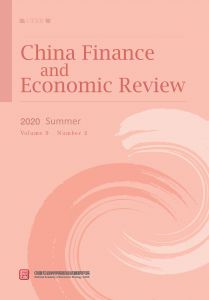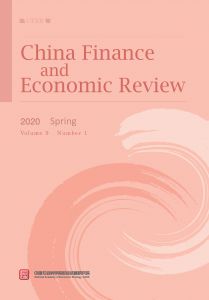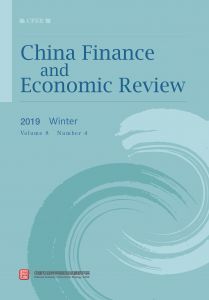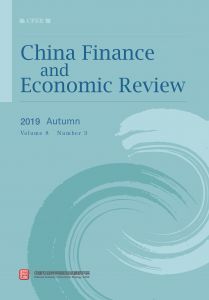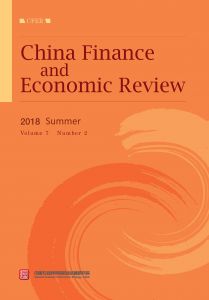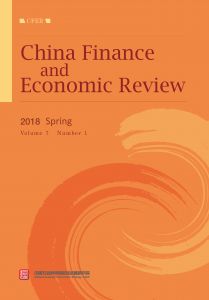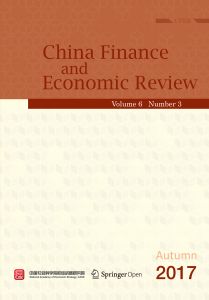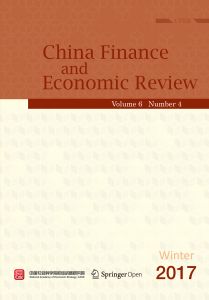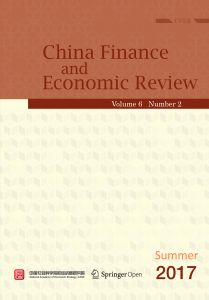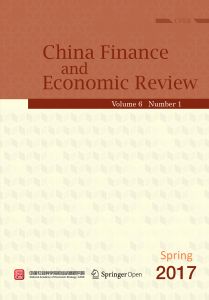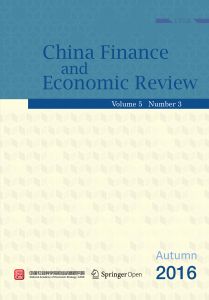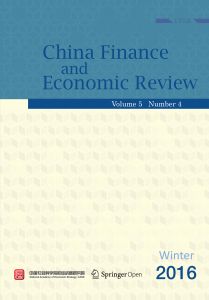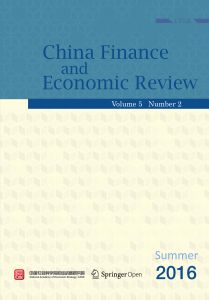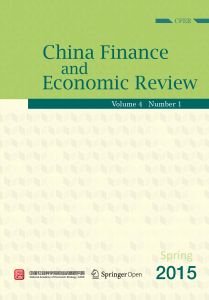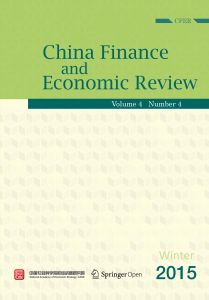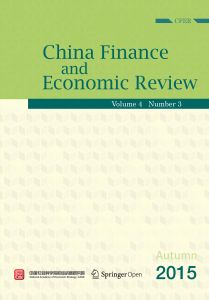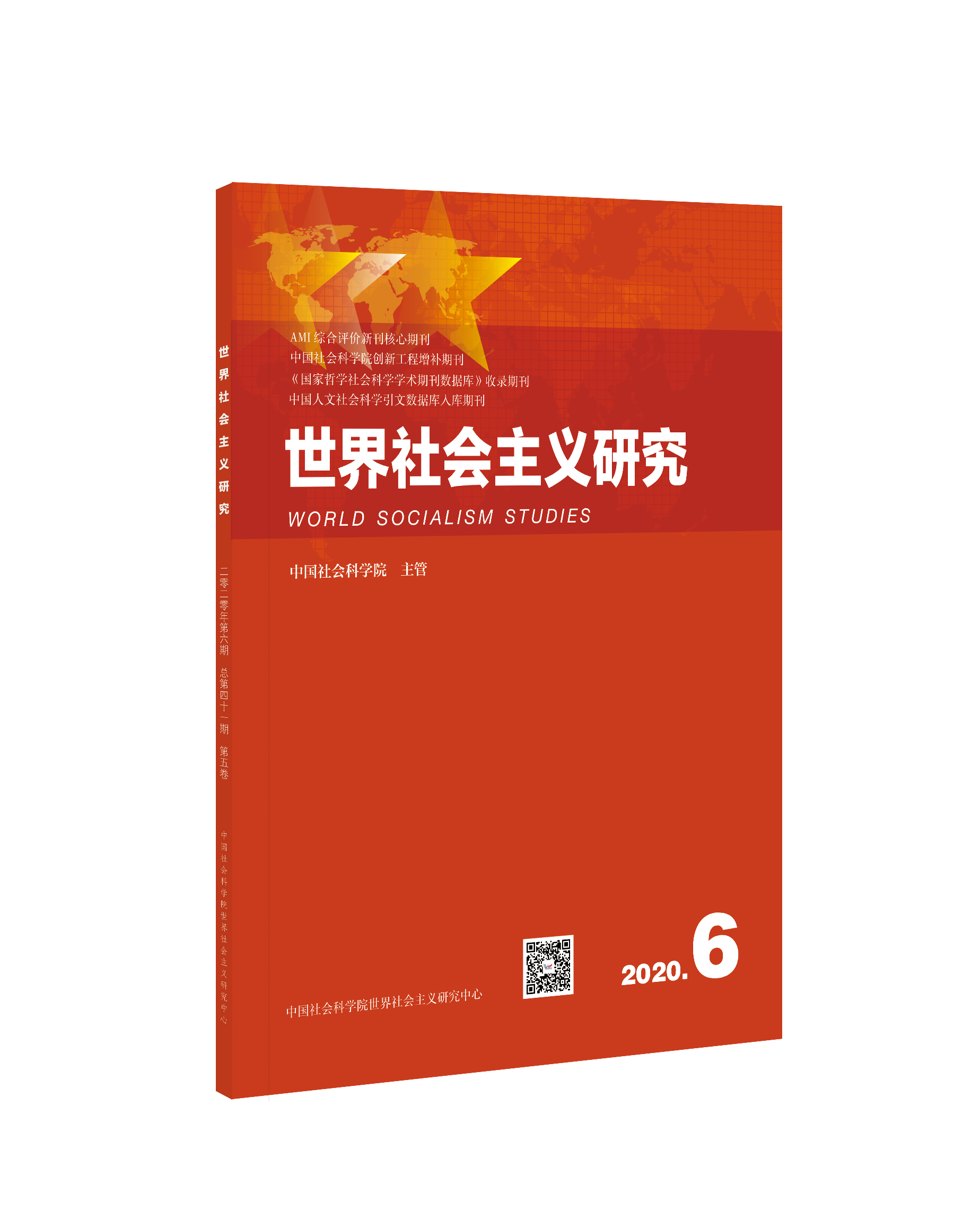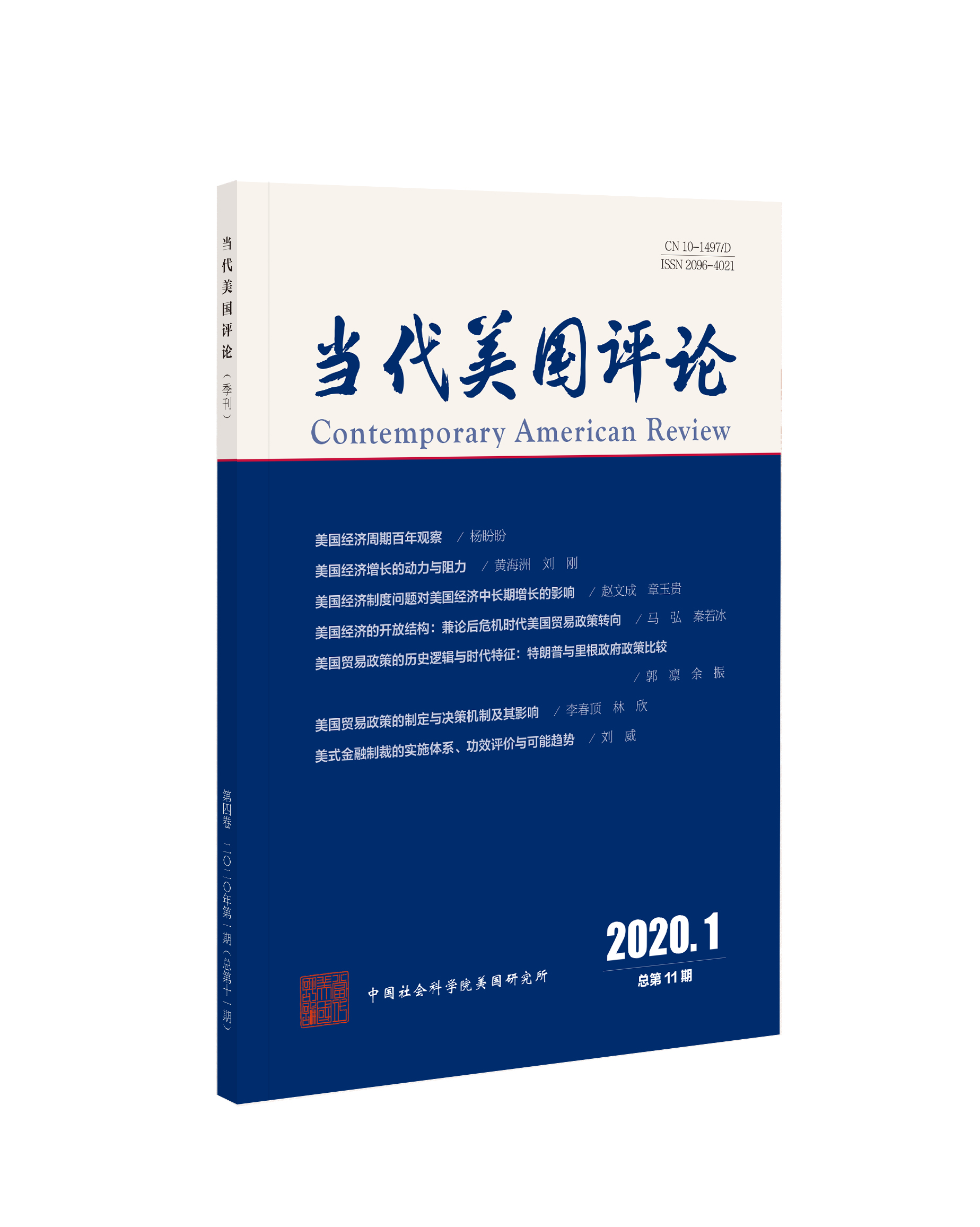最新期刊

目录
过往期刊
参考文献
-
Instructions for Authors
-
编委会
-
Potential Effect of Interprovincial Carbon Trading in China
-
1. Introduction
-
2. Research Method
-
3. Variable and Data Description
-
4. Estimation and Analysis of Shadow Price of Carbon Dioxide
-
5. Analysis of Simulation Results of Interprovincial Carbon Trading
-
6. Conclusion and Discussion
-
-
The Equalization Gap of Basic Public Services Supply in China: An Empirical Study on Education, Health Care and Social Security
-
1. Introduction
-
2. Theoretical Model and Hypothesis
-
3. Index Measuring and Variation Trend
-
4. The Empirical Test on the Realization Mechanism of Basic Public Services Supply’s Equalization
-
5. Main Conclusion and Policy Suggestions
-
-
Fiscal Expenditure, Trade Openness and Income Distribution
-
1. Introduction
-
2. Literature Review
-
3. Theoretical Analysis
-
4. Model, Indicators and Data Sources
-
5. Empirical Test
-
6. Further Test Based on Budget Structure and Expenditure Category
-
7. Main Conclusion and Policy Recommendations
-
-
Government Subsidies, Resource Misallocation and Manufacturing Productivity
-
1. Introduction
-
2. Theoretical Model
-
3. Measurement and Decomposition of Manufacturing Productivity
-
4. Impact of Subsidies on Manufacturing Productivity
-
5. Impact of Subsidies on Firm’s Market Entry, Exit and Scale
-
6. Conclusion and Recommendations
-
-
Developmental Path of Sharing Economy and Its Countermeasures Based on Blockchain Technology
-
1. Introduction
-
2. Connotation and Evolution of Sharing Economy
-
3. Developmental Barriers of Sharing Economy Relying on Big Data
-
4. Feasibility Analysis on Application of Blockchain Technology in Sharing Economy
-
5. Change of Sharing Economy Mode by Blockchain Technology and Status of Application of Blockchain Technology in Sharing Economy
-
6. Problems and Developmental Countermeasures of Application of Blockchain in Sharing Economy Mode
-
7. Enlightenment of Blockchain Technology for Chinese Sharing Economy in Future
-
8. Conclusion
-
-
China’s Government Investment Funds: Evolution, Risks and Reform Measures
-
1. Introduction
-
2. The Concept and Evolution of Government Investment Funds
-
3. Existing Problems and Risks of Government Investment Funds
-
4. Relevant Policy Recommendations
-
按年份浏览:
- 全部
- 2020
- 2019
- 2018
- 2017
- 2016
- 2015
- 2014
- 2013
[1]Barro, R. J., & Lee, J. W. (2013). A New Data Set of Educational Attainment in the World, 1950-2010. Development Economics , 104(C), 184-198.
[2]Battese, G. E., & Coelli, T. J. (1995). A Model for Technical Inefficiency Effects in a Stochastic Frontier Production Function for Panel Data. Empirical Economics , 20(2), 325-332.
[3]Chen, S. Y. (2009). Carbon Dioxide Emissions from Energy Consumption and Sustainable Development of Chinese Industry. Economic Research Journal (Jingji Yanjiu) , 4, 41-55.
[4]Chen, S. Y. (2010). Shadow Price of Industrial Carbon Dioxide: Parameterization and Non Parameterization Method. The Journal of World Economy (Shijie Jingji) , 8, 93-111.
[5]Coggins, J. S., & Swinton, J. R. (1996). The Price of Pollution: A Dual Approach to Valuing SO2 Allowances. Environmental Economics and Management , 30(1), 58-72.
[6]Cui, L. B., Fan, Y., Zhu, L., Bi, Q. H., & Zhang, Y. (2013). The Study on the Cost Saving Effect of Carbon Emissions Trading to Achieve China’s 12th Five-Year Emission Reduction Targets. Chinese Journal of Management Science (Zhongguo Guanli Kexue) , 1, 37-46.
[7]Cui, L. B., Fan, Y., Zhu, L., & Bi, Q. H. (2014). How Will the Emissions Trading Scheme Save Cost for Achieving China’s 2020 Carbon Intensity Reduction Target? Applied Energy , 136(31), 1043-1052.
[8]Fan, G; Wang, X. L., & Zhu, H. P. (2011). NERI Index of Marketization of China’s Provinces 2011 Report . Beijing: Economic Science Press. (in Chinese) Fogel, R. (1964). Railroads and American Economic Growth: Essays in Econometric History . Baltimore: Johns Hopkins University Press.
[9]Huang, Y. C., Zheng, J. H., Yang, Y. W., & Zhu, L. J. (2013). The Mystery of the Conflict between De-Industrialization of China and Re-Industrialization of United States. China Industrial Economics (Zhongguo Gongye Jingji) , 3, 7-19.
[10]Hübler, M., Voigt, S., & Löschel, A. (2014). Designing an Emissions Trading Scheme for China—An Up-To-Date Climate Policy Assessment. Energy Policy , 75(6), 57-72.
[11]Hueting, R. (1991). Correcting National Income for Environmental Losses: A Practical Solution for a Theoretical Dilemma, in National Income and Nature: Externalities, Growth and Steady State , Springer Netherlands, 23-47.
[12]Kuang, Y. F., & Peng, D. Y. (2012). China’s Environmental Production Efficiency and Environmental Total Factor Productivity Analysis. Economic Research Journal (Jingji Yanjiu) , 7, 62-74.
[13]Kuosmanen, T., & Kortelainen, M. (2007). Valuing Environmental Factors in Cost- Benefit Analysis Using Data Envelopment Analysis. Ecological Economics , 62(1), 56-65.
[14]Pang, T., Zhou, L., & Duan, M. S. (2014). Feasibility Analysis of China’s Carbon Emission Trading Pilot System. China Population, Resources and Environment (Zhongguo Rekou Ziyuan Yu Huanjing) , 9, 6-12.
[15]Psacharopoulos, G. (1994). Returns to Investment in Education: A Global Update. World Development , 22(9), 1325-1343.
[16]Shan, H. J. (2008). Re-estimation of China’s Capital Stock K from 1952 to 2006. The Journal of Quantitative & Technical Economics (Shuliang Jingji Jishu Jingji Yanjiu) , 10, 17-31.
[17]Smyth, R., Narayan, P. K., & Shi, H. (2011). Substitution between Energy and Classical Factor Inputs in the Chinese Steel Sector. Applied Energy , 88(1), 361-367.
[18]Steinbuks, J., & Narayanan, B. G. (2015). Fossil Fuel Producing Economies Have Greater Potential for Industrial Interfuel Substitution. Energy Economics , 47(4), 168-177.
[19]Sun, G. S., Huang, Y., Tian, H. F., & Wang, F. P. (2012). Total Factor Productivity, Investment Substitution and Inter-Regional Energy Efficiency. Economic Research Journal (Jingji Yanjiu) , 9, 99-112.
[20]Sun, R., Kuang, D., & Chang, D. Q. (2014). The Energy-Economic-Environment of Carbon Trading and Calculation of Reasonable Range of Carbon Price. China Population, Resources and Environment (Zhongguo Rekou Ziyuan Yu Huanjing) , 7, 82-90.
[21]Wei, S. D., & Wang, Q. Y. (2015). Effect of Environmental Regulation Policies in North and South Countries. Finance & Trade Economics (Caimao Jingji) , 11, 148-159.
[22]Wu, L. B., Qian, H. Q., & Tang, W. Q. (2014). The Carbon Emission Rights Trading and Carbon Tax Selection Mechanism Based on Dynamic Marginal Emission Reduction Cost Simulation. Economic Research Journal (Jingji Yanjiu) , 9, 48-61.
[23]Xie, J. G. (2006). Technology Spillover of Foreign Direct Investment: A Study Based on China’s Provincial Panel Data. China Economic Quarterly (Jingjixue Jikan) , 5(4), 1109-1128.
[24]Yao, X., & Liu, X. Y. (2010). The Most Effective Carbon Tax Based on Growth. Economic Research Journal (Jingji Yanjiu) , 11, 48-58.
[25]Yuan, Y. N., Li, N., & Shi, M. J. (2016). Construction of China’s multi Regional CGE Model and the Application in the Carbon Trading Policy Simulation. Mathematics in Practice and Theory (Shuxue Shijian Yu Renshi) , 46(3), 106-116.
[26]Zhang, C., Shi, D., & Wang, J. J. (2015). Potential Improvement Space for China’s Carbon Productivity. Resource Science (Ziyuan Kexue) , 37(6), 1218-1229.
[27]Zhang, J., Liao, H., Liang, Q. F., Zhou, Z. J., & Yu, G. S. (2009). The Impact of Carbon Tax and Carbon Emission Trading on China’s Industry. Modern Chemical Industry (Xiandai Huagong) , 29(6), 77-82.
[28]Argento, D., Culasso, F., & Truant, E. (2016). Competing Logics in the Expansion of Public Service Corporations. Utilities Policy , 40, 125-133.
[29]Ayansina, S. O., Oyeyinka, R., & Ayinde, A. (2015). Farmers’ Participation in the Services of Public and Private Extension Organizations in Southwestern Nigeria. British Journal of Applied Science & Technology , 8(3), 238-245.
[30]Borcherding, T. E., & Deacon, R. T. (1972). The Demand for the Services of Non-Federal Governments. American Economic Review , 62(5), 891-901.
[31]Chang, X. Z. (2007). The Study on the Equalization of Basic Public Services in China. Journal of the Party School of Tianjin Committee of the CPC (Zhonggong Tianjin Shiwei Dangxiao Xuebao) , 9(2), 66-71.
[32]Doel, H. V., & Velthoven, B. V. (1999). Democracy and Welfare Economics (translated by Chen G. at el ). Beijing: China Social Science Press, 56-57. (in Chinese)
[33]Gebremariam, G. H., Gebremedhin, T. G., & Schaeffer, P. V. (2012). County-Level Determinants of Local Public Services in Appalachia: A Multivariate Spatial Autoregressive Model Approach. Annals of Regional Science , 49(1), 175-190.
[34]Hu, Z. C. (2010). Some Thoughts on Promoting Equalization of Basic Public Services. Macroeconomic Management (Hongguan Jingji Guanli) , 8, 16-19.
[35]Jiang, M. R. (2006). The Theory of Basic Public Services’ Equalization. Journal of Zhongnan University of Economics and Law (Zhongnan Caijing Zhengfa Daxue Xuebao) , 3, 43-47.
[36]Kong, F. W., Zhang, X. F., & Liu, J. (2015). Evaluation and Analysis of the Equalization of Basic Public Services in Urban and Rural Areas in China. The World of Survey and Research (Diaoyan Shijie) , 7, 9-12.
[37]Li, P., & Chen, P. (2014). Urbanization, Fiscal Expenditure and the Gap between Urban and Rural Public Services. Research on Financial and Economic Issues (Caijing Wenti Yanjiu) , 9, 64-71.
[38]Liu, C. K., & Wang, C. C. (2011). Research on the Index System of Equalization of Basic Public Services in Urban and Rural Areas. Public Finance Research (Caizheng Yanjiu) , 8, 25-29.
[39]Lv, W., & Wang, W. T. (2008). Unbalanced Development, Public Services and Government Responsibility: An Analysis Based on Government Preference and Government Efficiency. Social Sciences in China (Zhongguo Shehui Kexue) , 29(4), 63-80.
[40]Qiao, Y. H., Hao, J. Z., & Li, C. (2015). Analysis of Effect Factors of the Implementation Effect of Equalization Project of Basic Public Health Service in Hebei Province. Review of Economic Research (Jingji Yanjiu Cankao) , 63, 94-98.
[41]Samuelson, P. A. (1954). The Pure Theory of Public Expenditure. Review of Economics & Statistics , 36(4), 387-389.
[42]Singh, T. (2010). Service Sector and Economic Growth in India. Applied Economics , 42(30), 3925-3941.
[43]Walle, S. V. (2009). When Is a Service an Essential Public Service? Annals of Public and Cooperative Economics , 80(4), 521-545.
[44]Wang, H. L. (2011). Constructing Urban and Rural Integrated Public Service Mechanism and Promoting Equalization of Public Services. Rural Economy (Nongcun Jingji) , 6, 44-48.
[45]Wang, Q. (2008). Theoretical Thinking on Equalization of Public Services in Urban and Rural Areas. Journal of Central University of Finance & Economics (Zhongyang Caijing Daxue Xuebao) , 8, 12-17.
[46]Wang, Q., & Wu, Q. Q. (2011). Changing Urban and Rural Duality Is the Key to Equalization of Basic Public Services in Urban and Rural Areas. Economic Forum (Jingji Luntan) , 7, 12-14.
[47]Wicksell, K. (1985). A New Principle of Just Taxation. Public Finance , 6, 15-19.
[48]Yoshida, M., & Kenmochi, T. (2011). Multiplier Effects of Public Services in a Two-Sector Model of Monopolistic Competition. Japanese Economic Review , 62(2), 272-288.
[49]Zeng, S. H., & Xia, J. C. (2016). Why Rapid Urbanization Process Cannot Improve Employment Absorption Capacity of Service Industry in China. China Finance and Economic Review , 4(1), 1-12.
[50]Zhang, G. F. (2011). On Equalization of Basic Public Services in Balancing Urban and Rural Development. Journal of Northwest University (Philosophy and Social Sciences Edition )(Xibei Daxue Xuebao (Zhexue Shehui Kexue Edition )), 41(5), 124-128.
[51]Zhang, K. Y., & Zhang, X. J. (2011). Public Services’ Equalization: Institutional Barriers and Development Ideas. Zhejiang Social Sciences (Zhejiang Shehui Kexue) , 6, 26-32.
[52]Zhao, B. T., & Fu, L. J. (2014).The Study of Government Behavior in the Equalization of Urban and Rural Public Services. Inner Mongolia Social Sciences (Inner Mongolia Shehui Kexue) , 35 (1), 106-109.
[53]Alesina, A., & Perotti, R. (1997). The Welfare State and Competitiveness. American Economic Review , 87(5), 921-939.
[54]Arawatari, R. (2015). Political Economy of Trade Openness and Government Size. Economics & Politics , 27(1), 28-52.
[55]Barro, R. J. (1990). Government Spending in a Simple Model of Endogenous Growth. Journal of Political Economy , 98(5) 103-125.
[56]Bergh, A., & Nilsson, T. (2010). Do Liberalization and Globalization Increase Income Inequality? European Journal of Political Economy , 26(4), 488-505.
[57]Chao, X. J., & Shen, K. R. (2014). Urban-Rural Income Disparity, Labor Quality and Economic Growth in China. Economic Research Journal (Jingji Yanjiu) , 6, 30-43.
[58]Cong, S. H. (2012). A Study on the Government Revenues and Expenditures to Adjust and Improve the Distribution of National Income. Finance & Trade Economics (Caimao Jingji) , 6, 15-20.
[59]Egger, H., & Etzel, D. (2012). The Impact of Trade on Employment, Welfare, and Income Distribution in Unionized General Oligopolistic Equilibrium. European Economic Review , 56(6), 1119-1135.
[60]Egger, H., & Kreickemeier, U. (2012). Fairness, Trade, and Inequality. Journal of International Economics , 86(2), 184-196.
[61]Foellmi, R., & Oechslin, M. (2010). Market Imperfections, Wealth Inequality, and the Distribution of Trade Gains. Journal of International Economics , 81(1), 15-25.
[62]Gao, L. J., & Mao, R. S. (2011). Trade Openness, Induced Employment Adjustment and the Scale Change of Chinese Local Government Real Expenditure. Economic Research Journal (Jingji Yanjiu) , 1, 42-56.
[63]Gao, X., & Huang, J. Z. (2016). Trade Openness, Factor Endowments and Provincial Government Scale in China: 1997—2013. Journal of International Trade (Guoji Maoyi Wenti) , 5, 164-176.
[64]Gu, G. D., & Ma, Y. (2015). Fiscal Expenditure Bias, Financial Constraints and China’s Trade Imbalance. Journal of International Trade (Guoji Maoyi Wenti) , 11, 156-164.
[65]Han, J., Liu, R. J., & Zhang, J. S. (2015). The Effect of Opening up to the Outside World on Income Distribution in China—An Empirical Examination of the Effects of Deng Xiaoping’s Talks Given in His Inspection Tour of Southern China and China’s Joining WTO. Social Science in China (Zhongguo Shehui Kexue) , 2, 24-40.
[66]Hong, Y., Yang, S. J., & Qin, Y. Q. (2014). Is Finance of People’s Livelihood Able to Reduce the Urban-rural Income Gap Effectively. The Journal of Quantitative & Technical Economics (Shuliang Jingji Jishu Jingji Yanjiu) , 7, 3-20.
[67]Hu, B., Chen, S. L., & Qiao, J. (2013). Influence of Trade Openness on Local Government Scale in China: An Empirical Study Based on Dynamic Spatial Panel Models. Journal of International Trade (Guoji Maoyi Wenti) , 8, 38-50.
[68]Hu, W. J., & Liu, Y. (2016). Fiscal Decentralization, Budget Structure and Local Governments’ Productive Expenditure Bias—Data Adjustment Analysis Based on Clause Subject. Contemporary Finance & Economics (Dangdai Caijing) , 5, 33-44.
[69]Jetter, M., & Parmeter, C. F. (2015). Trade Openness and Bigger Governments: The Role of Country Size Revisited. European Journal of Political Economy , 37, 49-63.
[70]Lei, G. Q., & Cai, X. (2012). The Distortion of Primary Income Distribution, Urban-Biased Fiscal Expenditure Policy and Urban-Rural Inequality. The Journal of Quantitative & Technical Economics (Shuliang Jingji Jishu Jingji Yanjiu) , 3, 76-89.
[71]Li, L., Liu, B., Hu, B., & Xie, L. (2011). The Impacts of Trade Openness on Urban Residents’ Income and Its Distribution. China Economic Quarterly (Jingjixue Jikan) , 11(1), 309-326.
[72]Li, Y. Y., & Shen, K. R. (2007). The Structure of Financial Expenditure, Relative Poverty and Economic Growth. Management World (Guanli Shijie) , 11, 14-26.
[73]Li, Z. G., & Han, X. Y. (2009). Theoretical Analysis and Empirical Test on Educational Fiscal Expenditure’s Impact on Gini Coefficient. Finance & Trade Economics (Caimao Jingji) , 8, 58-64.
[74]Lu, M., & Chen, Z. (2004). Urbanization, Urban-Biased Economic Policies and Urban-Rural Inequality. Economic Research Journal (Jingji Yanjiu) , 6, 50-58.
[75]Mao, J., Guan, H. H., & Lin, Z. X. (2015). Economic Openness and Government Size: New Findings from the History 1850-2009. Economic Research Journal (Jingji Yanjiu) , 7, 87-101.
[76]Mei, D. Z., & Gong, L. T. (2012). Do More Open Economies Have Bigger Governments? —Based on a Cross Countries Panel Data Analysis. China Economic Quarterly (Jingjixue Jikan) , 12(1), 243-264.
[77]Mo, Y. L., & Zhang, Z. C. (2011). Urbanization Process, Public Finance Expenditure and Income Distribution. The Journal of Quantitative & Technical Economics (Shuliang Jingji Jishu Jingji Yanjiu) , 3, 79-89.
[78]Ram, R. (2009). Openness, Country Size, and Government Size: Additional Evidence from a Large Cross-Country Panel. Journal of Public Economics , 93(1), 213-218.
[79]Rodrik, D. (1998). Why do More Open Economies Have Bigger Governments? Journal of Political Economy , 106(5), 997-1032.
[80]Shen, K. R., & Zhang, J. (2007). An Analysis of China’s Expenditure in Rural Areas and of the Performance. Management World (Guanli Shijie) , 1, 30-40.
[81]Tian, W. M. (2012). Calculation and Change Trend Analysis of Resident’s Income Gin iCoefficient of Provincial Areas. Economic Science (Jingji Kexue) , 34(2), 48-59.
[82]Wan, G. H., Lu, M., & Chen, Z. (2015). Globalization and Regional Inequality: Chinese Evidence. Social Sciences in China (Zhongguo Shehui Kexue) , 3, 17-26.
[83]Wan, H. Y., Tian, Z. L., & Xu, Y. C. (2015). China’s Rural Finance and Income Distribution in Villages. Management World (Guanli Shijie) , 11, 95-105.
[84]Wang, Y. F., & Zhu, Z. D. (2009). Trade Development, Labor Market Distortion and Factor Income Distribution Effect: Short-term Analysis Based on Special Factor. The Journal of World Economy (Shijie Jingji) , 1, 3-12.
[85]Wei, H., & Zhao, C. M. (2012). Effects of International Trade on Urban-rural Income Gap in China. Finance & Trade Economics (Caimao Jingji) , 1, 78-86.
[86]Wolff, E. N., & Zacharias, A. (2007). The Distributional Consequences of Government Spending and Taxation in the U. S., 1989 and 2000. Review and Income and Wealth , 53(4), 53-62.
[87]Wu, X., Perloff, J. M., & Golan, A. (2006). Effects of Government Policies on Urban and Rural Income Inequality. Review of Income and Wealth , 52(2), 213-235.
[88]Xu, X. Q., Zhang, Z. Y., & Kang, J. J. (2006). Fiscal Deficit and Trade Imbalance: Empirical Evidence of China from 1978 to 2003. The Journal of World Economy (Shijie Jingji) , 2, 41-50.
[89]Yang, B. (2013). Path Correction of Income Redistribution through Public Service Equalization in China. Taxation Research (Shuiwu Yanjiu) , 1, 3-9.
[90]Yin, D. S., Tang, H. Y., & Wang, Y. J. (2015). Skill Accumulation, Fiscal Policy and Salary Gap. Journal of World Economy (Shijie Jingji) , 10, 79-98.
[91]Zakaria, M., & Fida, B. A. (2016). Trade Openness and Income Inequality in China and the SAARC Region. Asian-Pacifc Economic Literature , 30(2), 33-44.
[92]Zhang, H. L., & Yuan, J. (2011). China’s Income Distribution in an Open Economy—A Review of China’s 10 Years in WTO. Finance & Trade Economics (Caimao Jingji) , 11, 14-22.
[93]Zhang, L., Li, J. Y., & Xu, X. X. (2012). Globalization, Biased Technological Change and Factor Shares. China Economic Quarterly (Jingjixue Jikan) , 11(2), 409-428.
[94]Zhao, Q. Y., & Zhang, J. W. (2013). The Evolution and the Driving Mechanism of Labor Income Share in China: An Analysis from the Perspective of International Trade and Minimum Wage. Journal of Financial Research (Jinrong Yanjiu) , 12, 44-56.
[95]Bernini, C., & Pellegrini, G. (2011). How are Growth and Productivity in Private Firms Affected by Public Subsidy? Evidence from a Regional Policy. Regional Science and Urban Economics , 41(3), 253-265.
[96]Brandt, L., Van Biesebroeck, J., & Zhang, Y. (2012). Creative Accounting or Creative Destruction? Firm-level Productivity Growth in Chinese Manufacturing. Journal of Development Economics , 97(2), 339-351.
[97]Dixit, A. K., & Stiglitz, J. E. (1977). Monopolistic Competition and Optimum Product Diversity. American Economic Review , 67(3), 297-308.
[98]Griliches, Z., & Regev, H. (1995). Firm Productivity in Israeli Industry 1979-1988. Journal of Econometrics , 65(1), 175-203.
[99]Hsieh, C., & Klenow, P. J. (2009). Misallocation and Manufacturing TFP in China and India. Quarterly Journal of Economics , 124(4), 1403-1448.
[100]Jiang, W., & Zhang., L. P. (2015). The Effect of Resources Misallocation of Subsidies Differentiation—An Analysis Based on the Perspective of Productivity Distribution. China Industrial Economics (Zhongguo Gongye Jingji) , 2, 31-43.
[101]Levinsohn, J., & Petrin, A. (2003). Estimating Production Functions Using Inputs to Control for Unobservables. Review of Economic Studies , 70(2), 317-341.
[102]Li, K., & Jiang, W. (2015). Market Entry and Economic Growth: An Empirical Analysis of China’s Manufacturing Industry. Economic Research Journal (Jingji Yanjiu) , 5, 48-60.
[103]Mao, Q. L., & Sheng, B. (2013). The Entry and Exit of Chinese Manufacturing Firms and the Dynamic Evolution of Productivity. Economic Research Journal (Jingji Yanjiu) , 4, 16-29.
[104]Melitz, M. J. (2003). The Impact of Trade on Intra-Industry Reallocations and Aggregate Industry Productivity. Econometrica , 71(6), 1695-1725.
[105]Nie, H. H., & Jia, R. X. (2011). Productivity of Chinese Manufacturing Firms and Resource Misallocation. The Journal of World Economy (Shijie Jingji) , 7, 27-42.
[106]Nie, H. H., Jiang. T., & Yang, R. D. (2012). The Usage Condition and Potential Problems of China’s Industrial Databases. The Journal of World Economy (Shijie Jingji) , 5, 142-158.
[107]Nie, H. H., Jiang, T., Zhang, Y. X., & Fang, M. Y. (2016). China Zombie Firms’ Research Report: Status, Causes and Countermeasures. Serial Reports of National Academy of Development and Strategy, Renmin University of China, No. 9.
[108]Olley, G. S., & Pakes, A. (1996). The Dynamics of Productivity in the Telecommunications Equipment Industry. Econometrica , 64(6), 1263-1297.
[109]Qian, X. F., Mao, H. T., & Xu, X. C. (2016). A New Framework for China’s Trade Interest Assessment—Based on the Perspective of Resources Misallocation Caused by Double Bias Policy. Social Sciences in China (Zhongguo Shehui Kexue) , 12, 83-108.
[110]Shao, M., & Bao, Q. (2012). Government Subsidy and Firm Productivity: An Empirical Analysis Based on China’s Industrial Firms. China Industrial Economics (Zhongguo Gongye Jingji) , 7, 70-82.
[111]Restuccia, D., & Rogerson, R. (2008). Policy Distortions and Aggregate Productivity with Heterogeneous Establishments. Review of Economic Dynamics , 11(4), 707-720.
[112]Wang, H. J., Li, Q. Y., & Liu, F. (2015). Government Subsidies: Saving the Emergency or the Poor—Empirical Evidence from Samples of Losing Firms. Nankai Management Review (Nankai Guanli Pinglun) , 18(5), 42-53.
[113]Xu, B. C., & Xie, J. G. (2015). Government Quality, Government Subsidies and Industry Total Factor Productivity. Economic Review (Jingji Pinglun) , 4, 45-56.
[114]Yan, Z. J., & Yu, J. P. (2017). Government Subsidies and Industry Total Factor Productivity—A Comparative Analysis Based on Emerging Industries and Traditional Manufacturing Industries. Industrial Economics Research (Chanye Jingji Yanjiu) , 1, 1-13.
[115]Alex, S. (2016). The Business of Sharing: Making it in the New Sharing Economy (translated by Han, J. J., Yang, Y., & Zhang, M.). Beijing: China Renmin University Press. (in Chinese)
[116]Amit, R., & Zott, C. (2001). Value Creation in E-Business. Strategic Management Journal , 22(6/7), 493-520.
[117]Bardhi, F., & Eckhardt, G. M. (2012). Access-Based Consumption: The Case of Car Sharing. Journal of Consumer Research , 39(4), 881-898.
[118]Bughin, J., Livingston, J., & Marwaha, S. (2011). Seizing the Potential of “Big Data”. McKinsey Quarterly , 4, 103-109.
[119]Fung, K. K., Kolar, S. H., & Karnam, P. (2007). Regulating Natural Monopoly—Flash Animation. Journal of Economic Education , 38(2), 255.
[120]Gao, C., & Guan, X. (2006). Achievement Mode and Evolution Mechanism of Business Mode Innovation of Enterprise: A Theoretical Interpretation Based on Value Chain Innovation. Chinese Industrial Economy (Zhongguo Gongye Jingji) , 11, 83-90.
[121]Hu, H. H., & Xing, H. (2003). Enlightenment of Industrial Integration Theory for the Development of Information Industry in China. Chinese Industrial Economy (Zhongguo Gongye Jingji) , 2, 23-29.
[122]Liu, Y., & Xia, J. C. (2016). Dynamics of Research on Theories and Policies of Sharing Economy. Economic Perspectives (Jingjixue Dongtai) , 4, 116-125.
[123]Rachel, B., & Roo, R. (2015). What’s Mine is Yours: The Rise of Collaborative Consumption (translated by Tang, C. W.). Shanghai: Shanghai Jiaotong University Press. (in Chinese)
[124]Robin, C. (2015). Peers Inc: How People and Platforms Are Inventing (translated by Wang, R.). Hangzhou: Zhejiang People’s Press. (in Chinese)
[125]Wang, C., & Wang, C. (2016). Blockchain Technology: Connotation, Application and Reshaping of Financial Industrial. New Finance (Xin Jinrong) , 10, 57-62.
[126]Wang, Q. (2011). nnovation of Enterprise Business Mode Based on Restructuring of Value Network. Chinese Industrial Economics (Zhongguo Gongye Jingji) , 1, 79-88.
[127]Waterson, M. (1989). Regulation of the Firm and Natural Monopoly. Economic Journal , 99(394), 103-120.
[128]Zhang, Y. (2016). Study on the Effect of Blockchain Technology on the Development of Chinese Financial Industry. International Finance (Guoji Jinrong) , 5, 41-45.
[129]Zheng, Z. L. (2016). Study on Developmental Path and Regulation of Sharing Finance in Internet Plus. Contemporary Economy & Management (Dangdai Jingji Guanli) , 8, 86-91.
[130]Lerner, J. (2012). Boulevard of Broken Dreams (translated by Qiao, J. T.). Beijing: Citic Press.
[131]Xiang, D. W., & Li, Z. Y. (2016). Government Equity Investment Funds: Questions, Analyses and Recommendations. Review of Economic Research (Jingji Yanjiu Cankao) , 19, 22-27.
[132]Zero2IPO Research. (2016). China Government Guidance Fund Development Research Report 2016.
[展开]
相关推荐
手机可扫码阅读


